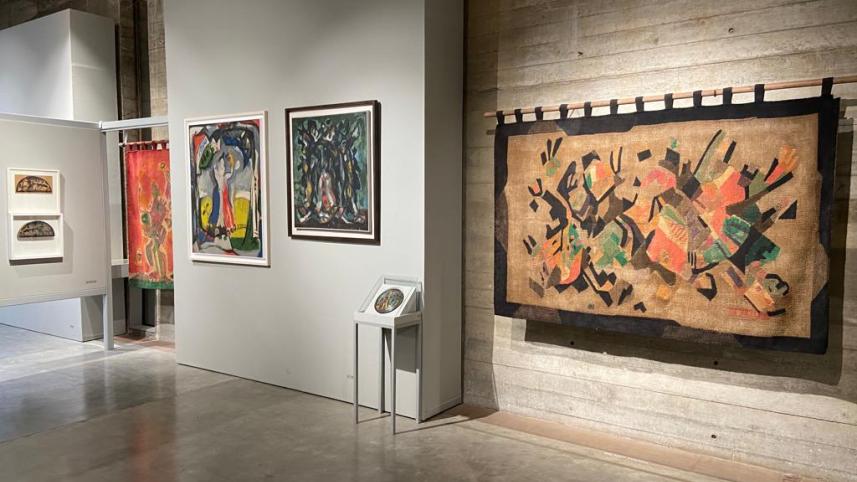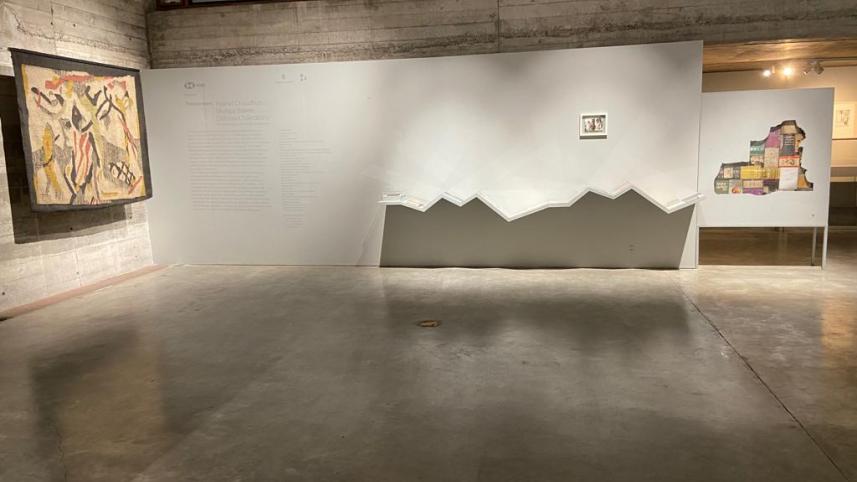Going back to the roots

A draw-bridge is let down to connect the 'now' with the 'then', with the caveat that the past is the product of the shifts and changes that occurred over time and in-between—this, in essence, is the vantage this exhibition is perched on.
A noble and courageous effort no doubt, especially considering how in the broader scheme, it deals with the advent of art pedagogy in Bangladesh which erupted onto the local scene—one that is a volatile brew of political and cultural upheaval, as an extension of the universal medium and method of art practice of the historical period of modernism.
The three leading figures ascribed to have laid the foundation of formal art education in Chattogram: Rashid Choudhury, Murtaja Baseer and Debdas Chakraborty had carved a path for artists to follow, to turn their vocation into an academic pursuit with wider implications.
In a port city rife with cross-cultural pollination, the art institute became yet another means to channel in foreign influence. But Dhali Al Mamoon, the curator of the exhibition, who has a myriad of artistic feats to his credit, argues that these Western educated artists, who were simultaneously bearers of the traditions of art practice that germinated out of the soil of the sub-continent, were at varied degrees somewhat a lopsided mix of West meets East.

Now, the 'East' was also a hybridised plane where modernism as such could not manifest itself in the norm-fitting attributes (in itself a non-sequitur), but was rather acclimatised or reformed along various contact points or fault-lines where indigenous artistic clime, forms and contents vied for privilege for the very reason of sui generis.
The changing times that saw the multiple, violent divisions of the sub-continent and mass exodus across the new borders, engendered by spurious identity politics, brought in its manifold wake a collective state of being heavily stamped by dislocation and alienation, experienced by the peoples who carried memories of the past and present traumas.
This peculiar condition was well suited for an adaption of which came to be known as the modernist approach to art. Art offered itself as a vehicle for self-determination, or an urge to lodge oneself into a concept of originary belonging to an (contrived) ontology pregnant with genealogical identifiers.
Zainul Abedin was taken on-board to draw out a curriculum for this newly formed institution at a time when his disciples were more ready to break free from his brand of nationalist art-discourse to express their solidarity with international trends, with abstraction taking precedence amongst them.
Amongst the trio, Rashid Choudhury through his artworks and interviews showed a predilection for letting the rural iconography infiltrate his formalist pictorial planes. While Baseer allowed his abstract fantasies to take root in his grounded (contextualised) realism evident in textual/material representations, little evidence was presented in terms of the paraphernalia that shed light on Chakraborty's 'coming-into-his-artist-self'. He came across as the creator of an iconic and somewhat jingoistic poster who also painted visual renditions of inner-states/moods; he as an artist and an individual appeared more like an island unto himself, or so it seemed from the specimen presented.

Interlacing artworks are catalogues, hand written curricula, a segment of a personal library, pages from journals, poetry—all of which evoke a time and space that helped shape the trajectories of these minds, and their becoming.
The title of the exhibition prompts one that these aesthetes were also educators. The upper story of the main hall hosts projections on walls that explore details of commissioned public art by Baseer and Choudhury, while the dimly-lit bunker like storage space rings with overlapping audio recordings of interviews.
The photographs hung on walls of the mezzanine level overlooking a would-be auditorium which depict murals/objects of interest taken during a research project in India by Baseer transports one across time, at the same time transfiguring one's experience of what is seen as it creates a parallax of a continuum dissolving now-then, here-elsewhere.
Nowhere than in this space has Dhali been able to create a theatrical (re)presentation of a genesis that continues to flow into the present, where the gaze expands and engages with the timeless (echoing the words of Rashid Choudhury), and transverses the 'categories' of 'I vs other/us vs them'.
The rest of the exhibition is housed in a site, whose imposing, bare-skinned structure is kind of reminiscent of post-industrial, up-cycled conversion of an industrial site. Inside, on a wall the three stalwarts stare back framed in a photograph, dwarfed by its scale.
Quotes on the walls of the rising stairwell and the ones leading to the hall are akin to groundwork preparing one for what's to come once the threshold is crossed. The rotating cylinders along the entrance display vestiges and vignettes from a zeitgeist avowedly intertwined with the growth and spread of the discourse/context of modernism, or simplified—the acts of self-questioning and excavating the accoutrements that went into the cauldron to create the broth of selfhood, self-identity.

In a nutshell this is exactly what this exhibition is attempting to bring into view, the making of three modernist artists—although variedly engaged in the search of a localised, personalised idiom of art.
The exhibition entitled "Forerunners: Rashid Choudhury, Murtaja Baseer, Debdas Chakraborty – Their pedagogy and modernist approach" is running at Bengal Shilpalay until June, 18 2022. A panel of eminent speakers further illumined the practice of modernism in the works of the pioneers in an ancillary session, "Art Talk: Our modernity and its context". This exhibition, visionary in its scope and purport was organised by Bengal Foundation and supported by HSBC Bangladesh.



 For all latest news, follow The Daily Star's Google News channel.
For all latest news, follow The Daily Star's Google News channel.
Comments